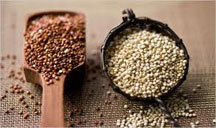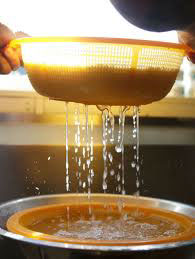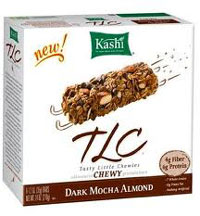Become an Arsenic ELIMINATOR!
By Alice Osborne
I get updates from the Environmental Working Group (EWG) almost weekly. And while I know we can carried away with all the hype around the bad stuff in our food today, we can appreciate the heads-up without wringing our hands and slipping into despair.
I share one of their latest alerts because folks with diabetes and pre-diabetes (insulin resistance) need to be hyper-vigilant about toxins and contaminants in their food. These things weaken the immune system and wreck havoc with vital organs. Those of us that deal with sugar issues already have vulnerable organs at best.
 Recently they sent an alert about extra high measurements of arsenic that's not just showing up in water, but now in our grains. Rice in particular. Sonya Lunder, EWG Senior Research Analyst and Dawn Undurraga, EWG Nutritionist explained that the latest reports from the US Food and Drug Administration and the highly regarded Consumer Reports magazine, talk about the worrisome amounts of arsenic in rice and popular rice-based processed foods. Although scientists and government regulators have long known about the ever-present threat of arsenic in our diet and water, it was unsettling when two major reports came out on the same day (Sept. 19, 2012) reminding us of the risk and the need to do what we can to minimize it.
Recently they sent an alert about extra high measurements of arsenic that's not just showing up in water, but now in our grains. Rice in particular. Sonya Lunder, EWG Senior Research Analyst and Dawn Undurraga, EWG Nutritionist explained that the latest reports from the US Food and Drug Administration and the highly regarded Consumer Reports magazine, talk about the worrisome amounts of arsenic in rice and popular rice-based processed foods. Although scientists and government regulators have long known about the ever-present threat of arsenic in our diet and water, it was unsettling when two major reports came out on the same day (Sept. 19, 2012) reminding us of the risk and the need to do what we can to minimize it.
 In some parts of the world, contamination levels are so high in food and water as to cause epidemics of skin, bladder and lung cancer. The National Academy of Sciences estimated that people drinking arsenic-contaminated water at 10 parts per billion would have a 1-in-300 risk of developing cancer over their lifetimes. Recent research suggests that people ingest about that much arsenic in a just a half-cup serving of rice, not an unusual amount for millions of Americans.
In some parts of the world, contamination levels are so high in food and water as to cause epidemics of skin, bladder and lung cancer. The National Academy of Sciences estimated that people drinking arsenic-contaminated water at 10 parts per billion would have a 1-in-300 risk of developing cancer over their lifetimes. Recent research suggests that people ingest about that much arsenic in a just a half-cup serving of rice, not an unusual amount for millions of Americans.
So here's where the EWG enters the scene: They want us to know that many rice-based foods and some fruit juices have arsenic levels much higher than are allowed in drinking water. And contrary to some denials from the food industry, the contamination does include the form of arsenic that poses a serious risk to our health. It's long overdue for federal agencies to set health-protective limits on arsenic in food, but they are not moving quickly. In the meantime, here are some easy-to-use tips on how we can reduce our exposure:
•  Limit rice consumption and vary your diet. Try alternative grains such as quinoa, barley, grits/polenta, couscous or bulgur wheat. And look for alternatives to rice-based processed foods such as breakfast cereals, rice flour, rice pasta, rice cakes and crackers. You can also find flour mixes that contain no rice or gluten for baking.
Limit rice consumption and vary your diet. Try alternative grains such as quinoa, barley, grits/polenta, couscous or bulgur wheat. And look for alternatives to rice-based processed foods such as breakfast cereals, rice flour, rice pasta, rice cakes and crackers. You can also find flour mixes that contain no rice or gluten for baking.
Consumer Reports testing confirmed that rice has much higher concentrations of arsenic than other grains, fruits and vegetables. That's partly because rice is often grown in fields that have been treated with arsenic-based pesticides in the past. But in many cases it's because rice plants have a natural tendency to take up and concentrate naturally occurring arsenic in the soil and water. While the FDA needs to test 1,000 more rice samples to clarify which rice-growing areas present the greatest risk of contamination, we can take protective steps until they get their data collected and studied (a process that could take years).
•  Rinse your rice thoroughly. Boil brown rice in a lot of water (as you do with pasta). Research indicates that the amount of arsenic in rice can be lowered by 30%-to-40% if you take this simple step (the more water the better). (Unfortunately, white rice doesn't hold up well to this kind of cooking, but you can reduce arsenic levels somewhat by rinsing white rice before you cook it.)
Rinse your rice thoroughly. Boil brown rice in a lot of water (as you do with pasta). Research indicates that the amount of arsenic in rice can be lowered by 30%-to-40% if you take this simple step (the more water the better). (Unfortunately, white rice doesn't hold up well to this kind of cooking, but you can reduce arsenic levels somewhat by rinsing white rice before you cook it.)
•  Limit products that list rice syrup as a sweetener. A recent study by scientists at Dartmouth College found high arsenic levels in processed foods sweetened with brown rice syrup, which are often aimed at the "natural" foods market. Read labels to avoid this sweetener wherever possible.
Limit products that list rice syrup as a sweetener. A recent study by scientists at Dartmouth College found high arsenic levels in processed foods sweetened with brown rice syrup, which are often aimed at the "natural" foods market. Read labels to avoid this sweetener wherever possible.
•  Do not use rice milk as a dairy substitute for cow's milk. Britain's Food Safety Authority also says to avoid rice milk as a dairy alternative. Consumer Reports tested two common brands for arsenic and found that all samples exceeded EPA's drinking water limit of 10 parts per billion. The range in rice milk was 17 to 70 parts per billion. Almond milk is a better choice, for instance.
Do not use rice milk as a dairy substitute for cow's milk. Britain's Food Safety Authority also says to avoid rice milk as a dairy alternative. Consumer Reports tested two common brands for arsenic and found that all samples exceeded EPA's drinking water limit of 10 parts per billion. The range in rice milk was 17 to 70 parts per billion. Almond milk is a better choice, for instance.
•  Check your drinking water. Arsenic taints drinking water in many parts of the United States. Check EWG's Tap Water Database (found at EWG.org) to see if it's been detected in your water. If you drink well water, contact your local health department to find out if arsenic could be a problem in your well, or get it tested - it's not expensive and it's worth the investment.
Check your drinking water. Arsenic taints drinking water in many parts of the United States. Check EWG's Tap Water Database (found at EWG.org) to see if it's been detected in your water. If you drink well water, contact your local health department to find out if arsenic could be a problem in your well, or get it tested - it's not expensive and it's worth the investment.
•  The bottom line? Become an ARSENIC ELIMINATOR!
The bottom line? Become an ARSENIC ELIMINATOR!
There's no need for hand-wringing, just label-reading. Awareness and prevention - those are the best tools for maintaining our health!
Sources:
www.ewg.org
www.thekitchen.com
www.topics.nytimes.com
www.bonappetit.com
www.chitowncheapskate.com
www.snackerrific.com
www.ewg.org
www.nasawatch.com

